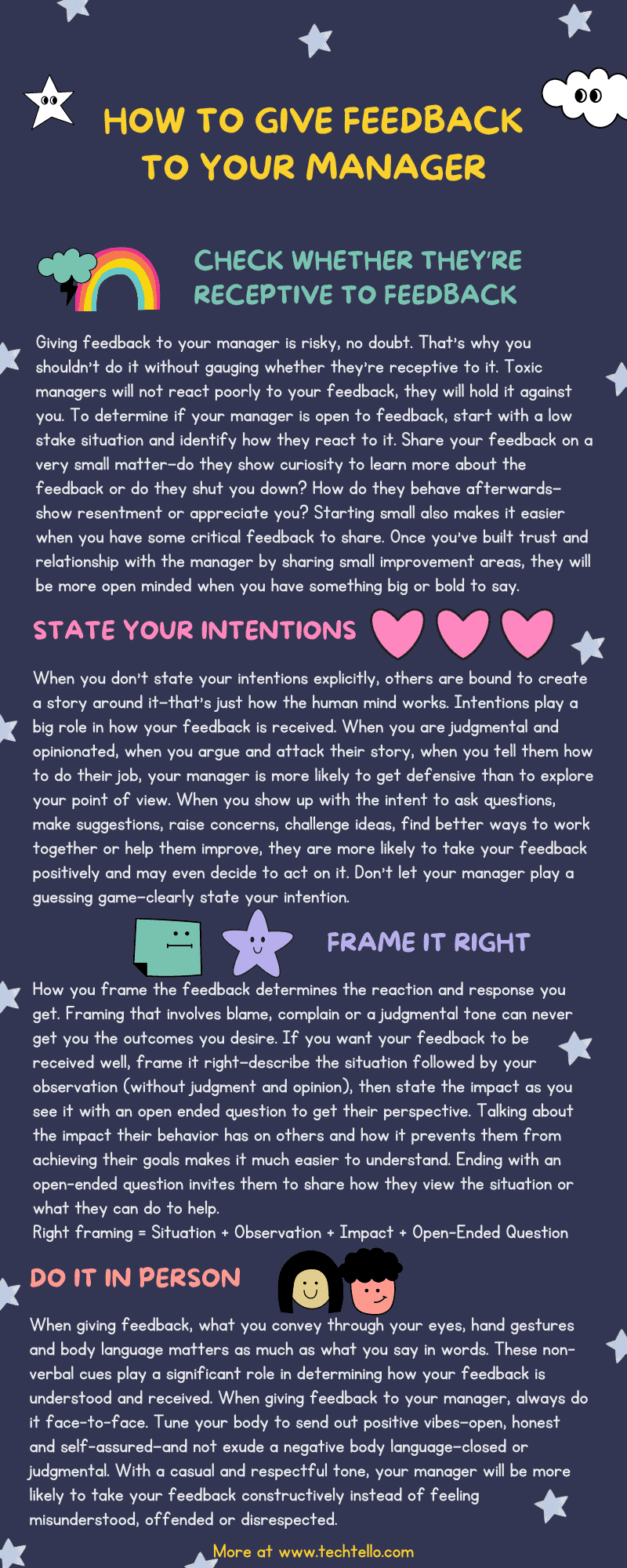How To Give Feedback To Your Manager

Giving feedback to your manager can be tricky.
What if they don’t like what you say?
What if they take it the wrong way?
What if they turn against you?
People refuse to give candid feedback to their managers because they don’t want to put their jobs at risk.
This prevents most managers from getting an accurate picture of how others view them, often creating a huge gap between perception and reality.
When you don’t share what they need to hear, don’t expect your manager to improve or blame them for repeating behaviors and actions that hurt their team and impact your productivity and performance.
Just like your manager is expected to share constant feedback to help you learn and grow, you also need to contribute to your manager’s growth. All managers have blind spots—unknowns that are in their circle of awareness (known unknowns) and things they don’t even know (unknown unknowns).
There are lurking gaps in how they see themselves (or their actions) and how others perceive them leading to inadvertent blind spots. This is further exacerbated by their past beliefs, experiences, upbringing and many other psychological factors. Without reconciling reality, these blind spots perpetuate disconnect and dissonance with people.
It may be uncomfortable at first to tell your manager what they’re doing wrong—you’ve to fight your fears and resist your instinct to avoid dealing with them. But with practice and experience, you’ll get better at it. Your courage will inspire others to do it too, contributing to a healthy workplace with a feedback rich environment.
When you give yourself permission to communicate what matters to you in every situation you will have peace despite rejection or disapproval. Putting a voice to your soul helps you to let go of the negative energy of fear and regret.
— Shannon L. Alder
Help your managers become better leaders by giving them the feedback they need. Follow these practices to ensure your feedback lands right:
Check whether they’re receptive to feedback
Giving feedback to your manager is risky, no doubt. That’s why you shouldn’t do it without gauging whether they’re receptive to it.
Toxic managers will not react poorly to your feedback, they will hold it against you. These managers believe in power structures where feedback is expected to flow only in one direction—from top to bottom. They take feedback personally as it hurts their ego and questions their place in the hierarchy. They are blind to their flaws and refuse to address them. Instead of treating feedback as a gift, they treat it as a slap in the face.
To determine if your manager is open to feedback, start with a low stake situation and identify how they react to it. Share your feedback on a very small matter—do they show curiosity to learn more about the feedback or do they shut you down? How do they behave afterwards—show resentment or appreciate you?
Starting small also makes it easier when you have some critical feedback to share. Once you’ve built trust and relationship with the manager by sharing small improvement areas, they will be more open minded when you have something big or bold to say.
Don’t waste your time and energy on a manager who treats feedback as a one-way street. It’s time to change teams or find another job if they aren’t receptive to feedback and their behavior is getting in the way of your growth.
State your intentions
When you don’t state your intentions explicitly, others are bound to create a story around it—that’s just how the human mind works.
Intentions are invisible. We assume them from other people’s behavior. In other words, we make them up, we invent them. But our invented stories about other people’s intentions are accurate much less often than we think.
— Douglas Stone, Difficult Conversations
Intentions play a big role in how your feedback is received. When you are judgmental and opinionated, when you argue and attack their story, when you tell them how to do their job, your manager is more likely to get defensive than to explore your point of view.
When you show up with the intent to ask questions, make suggestions, raise concerns, challenge ideas, find better ways to work together or help them improve, they are more likely to take your feedback positively and may even decide to act on it.
Don’t let your manager play a guessing game—clearly state your intention.
For example, you may say:
My intent is to find better ways to communicate so that we can avoid communication gaps.
My intent is to find the best possible solution. I want to discuss how we can encourage more disagreements in the team.
My intent is to get more visibility around my work. Can we discuss how you can enable this for me as a manager?
Explicitly stating what you desire from the conversation and why you’re approaching them prevents them from attaching their own meaning. They can focus on the solution when they know you have their best intentions at heart.
Master Difficult Conversations
Engage in healthy dialogue, build stronger relationships and achieve a better outcome.
Frame it right
Your manager has hundreds of things to do, most of which are not visible to you. It’s very important for you to realize that you may not have all the context to understand why your manager behaved a certain way in a particular situation unless you’re actually doing your manager’s job.
So instead of judgment, lead with observation. Leave room for understanding and curiosity. Don’t draw conclusions from your limited interactions with your manager and treat them as a source of truth.
How you frame the feedback determines the reaction and response you get. Framing that involves blame, complain or a judgmental tone can never get you the outcomes you desire. If you want your feedback to be received well, frame it right—describe the situation followed by your observation (without judgment and opinion), then state the impact as you see it with an open ended question to get their perspective.
Talking about the impact their behavior has on others and how it prevents them from achieving their goals makes it much easier to understand. Ending with an open-ended question invites them to share how they view the situation or what they can do to help.
Right framing = Situation + Observation + Impact + Open-Ended Question
For example:
Instead of: You don’t care about our ideas.
Say: In our meeting yesterday, you asked the team for their input (situation). However, I noticed that whenever someone shared their viewpoint that didn’t align with the original idea, you dismissed their suggestion without exploring it completely (observation). Rejecting ideas this way makes the team feel that their opinions don’t matter. They will be demotivated to speak up next time around (impact). How do you suggest we encourage healthy disagreements in the team while aligning on the goal of finding the best possible solution (open-ended question)?
Instead of: You don’t trust us with more responsibilities.
Say: I wanted to discuss work allocation and responsibilities in the team (situation). I have noticed that you always have too many things to do in a day. At the same time, the team feels more than ready to take on additional responsibilities (observation). Not getting an opportunity to handle next level responsibilities is preventing the team from growing while doing all that work by yourself must be leaving you tired and exhausted (impact). What do you suggest we can do to gain your trust so that you can delegate more work to the team (open-ended question)?
Here are a few do’s and don’ts of framing it right:
- Don’t tell them how to do their job.
- Don’t generalize or attack their character. Focus on a specific behavior or action.
- Don’t be opinionated or fixated on a single point of view. Show flexibility to change your point of view.
- Don’t presume you have complete visibility into their situation.
- Be respectful and polite.
- Seek their input or advice. It makes them invested in the problem.
- Embrace silence. Give them time to chew on the information.
Framing your solution negatively, such as “Don’t shout at me,” tends to focus the other’s attention even more on the unwanted behavior and may unconsciously reinforce it, particularly if you are shouting back at them. It is more effective to say, quietly, “Please talk to me in a quiet tone.” Focus the other’s mind clearly on the positive action you want them to take.
— William Ury, The Power of a Positive No
When giving feedback to your manager, take time to decide what you’re going to say. Without thinking about it upfront, you may say things that you regret later.
Do it in person
When giving feedback, what you convey through your eyes, hand gestures and body language matters as much as what you say in words.
These non-verbal cues play a significant role in determining how your feedback is understood and received. While giving feedback to your manager, it may be easy to drop an email, message or do it over a phone call. But your chances of being misunderstood or not delivering feedback effectively goes higher when you avoid meeting them in person.
When giving feedback, it’s very important for both the feedback giver and the receiver to observe the body language.
Carrying yourself in a powerful way directs your feelings, thoughts, behaviors, and body to feel powerful and be present (and even perform better) in situations ranging from the mundane to the most challenging.
— Amy Cuddy, Presence
Your positive body language can speak a lot about your intention and can guide the conversation in a positive direction. Your manager’s body language can serve as a hint on how they’re processing the information and give you useful signals on whether to continue speaking or keep your mouth shut.
When giving feedback to your manager, always do it face-to-face. Tune your body to send out positive vibes—open, honest and self-assured—and not exude a negative body language—closed or judgmental. With a casual and respectful tone, your manager will be more likely to take your feedback constructively instead of feeling misunderstood, offended or disrespected.
Respect is like air. As long as it’s present, nobody thinks about it. But if you take it away, it’s all that people can think about. The instant people perceive disrespect in a conversation, the interaction is no longer about the original purpose—it is now about defending dignity.
— Ron McMillan, Crucial Conversations
Summary
- Your manager is not perfect. They too have gaps much like everyone else. Don’t avoid giving them feedback just because it’s uncomfortable and risky.
- Not all managers are receptive to feedback. Some might hold it against you. Start with a low stake situation, share feedback with your manager and gauge their reaction.
- Your intentions play a significant role in how your feedback is perceived. Don’t leave your manager guessing or attach meaning to your words. Clearly state your intention.
- Right framing of the feedback can get your managers attention and invite them to problem solve instead of turning defensive.
- Always give feedback to your manager face-to-face. Don’t ignore the power of your body language—what you convey through non-verbal cues matters as much as what you say in words.






























